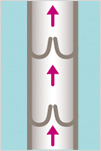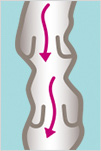An Introduction to Varithena® (polidocanol injectable foam)
This treatment is done only by the physician himself.
What are varicose veins?
Varicose veins are the large, “rope-like” veins which are often one-quarter inch or larger in diameter.
What causes varicose veins?
Varicose veins occur when veins are not properly returning blood from the lower leg to the heart. All veins have valves that open to allow the flow of blood to the heart and close to prevent back flow (otherwise know as “reflux”) of blood to the foot. When valves fail to function properly, blood leaks through and flows down the leg in the wrong direction. The blood overfills and distends the superficial veins under the skin, resulting in the bulging seen in varicose veins. The walls and valves of veins are thin and elastic, and can stretch due to a variety of conditions including pregnancy, heredity and age. When varicose veins become severe, it is referred to as chronic venous insufficiency. Symptoms of chronic venous insufficiency include aching pain, easy leg fatigue and leg heaviness, all of which worsen as the day progresses. Left untreated, chronic venous insufficiency can cause ulcerations which can be very difficult to treat.
In our clinic we also use the latest technology like Varithena® (polidocanol injectable foam) is the FDA-approved foam treatment for varicose veins(accepted by the most insurances) in the great saphenous vein (GSV) system of the leg.
Ultrasound guided foam sclerotherapy (UGFS) is the latest development in the sclerotherapy field. The principle is the same as conventional sclerotherapy. The sclerosant is used to obliterate varicose veins. The new points in this technique are that the liquid sclerosant is agitated to produce a foam-like mixture which is basically air that is mixed with sclerosant, the use of foam appears to maximize the effect of the injection. Foam becomes less diluted than liquid when injected into the vein allowing more high-strength solution to come into contact with the vein wall, The result is that less solution has to be injected in order to get the same effect, and the success rate is higher.
In essence, UGFS is a safe and highly effective out-patient procedure which eliminates the deeper diseased veins hidden from view that have traditionally required surgical removal. Here is a brief explanation of this important advance in the treatment of varicose veins. Until recently, sclerotherapy was thought to be effective only for spider veins and small varicose veins that remain after surgery. But since 1990, the use of duplex ultrasound (DUS) has enabled the precise anatomic location of abnormal “saphenous” veins and their tributaries, so that injections of powerful sclerosing agents directly into these veins can be accurately delivered for effective and durable results. DUS thus serves both to provide a diagnostic functional map, and to guide the actual injection process. The patient benefits by avoiding Xray contrast studies (venography), while eliminating the targeted saphenous veins without the disadvantages of surgery (higher risks and costs, recuperation time, and scars).
Duplex ultrasound is the key to the success of this procedure. First, it locates the diseased “saphenous” vein(s) hidden from view that cause the more obvious bulging surface varicosities. Next, DUS guides both the placement and number of injections according to individual response. Later, follow-up DUS examinations confirm success, and guide additional treatment when necessary.
The success of both surgery and sclerotherapy depends on accurate control of all reflux (backward flow) points. Due to recent advances, both methods now share a similarly high success rate when performed by experienced practitioners who accurately target the diseased veins using DUS. However, published studies show that most patients prefer sclerotherapy if given the choice.
This procedure improves the veins appearance, reduces the heaviness,achiness, swelling and itching in the legs related to venous insufficiency and prevents the formation of Venous ulcers in the legs.
We accept most insurance plans. (702) 838-0444



